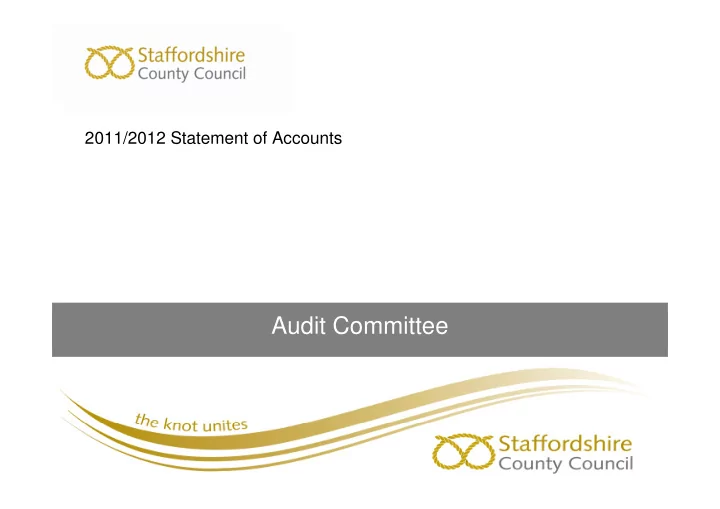

2011/2012 Statement of Accounts Audit Committee
Purpose of Report In accordance with the Accounts and Audit Regulations 2011 (the Regulations) the Authority is required to approve the Statement of Accounts. The Chair of Committee of a relevant body, which approves the Statement of Accounts is required to sign and date the accounts. For this authority this is the Audit Committee.
Stewardship concept • Overriding objective of financial reporting is to demonstrate fiduciary stewardship. • But need to see the accounts in context with other arrangements. Wider objective of public stewardship – operational stewardship e.g. value for money reviews, audit reports, inspections etc.
Period of Account • Year - 1 April to 31 March. • Draft accounts signed by the responsible financial officer by the end of June. • 4 weeks public inspection (25 th June to 20 th July). • Audited accounts before 30 September.
How are the accounts prepared? • Range of principles and practices. • Code of Practice on Local Authority Accounting. • Prepared, signed and dated by responsible financial officer. • Presents a ‘true and fair’ view. • External auditors appointed by the Audit Commission (PricewaterhouseCoopers).
Accounting concepts and principles Many principles but main things to note are: - Materiality - Accruals
What is the Statement of Accounts ? • Formal accounts of the Council • What did the authority’s services cost in the year of account? • Where did the money come from? • What were the authority’s assets and liabilities at the year-end? • Readers of the Statement of Accounts - electors, members, employees and other interested parties
Heritage Assets • In accordance with the 2011/12 code of practice on local authority accounting (FRS30 Heritage assets), the County Council now has to disclose its heritage assets on the balance sheet (page 86). • The disclosure of heritage assets has to be made retrospectively (note 1, pages 88-91). • A heritage asset is defined as an asset with historical, artistic, scientific, technological, geophysical or environmental qualities that is held principally for its contribution to knowledge and culture.
Heritage Assets (Continued) • The Museums and Archives services hold the County Council’s heritage assets. The assets are held at Shugborough, in the Shire Hall Gallery, in County Buildings and in the Judges’ House. • In total the County Council holds £8.8m worth of heritage assets. Among the most valuable assets are the Sutherland papers which the Council purchased in March 2006 for £1.8m.
What else should the reader of the accounts be aware of? • Prior year adjustments (note 1, pages 88-91) • Provisions (note 18, page 113) • Reserves (Movement in Reserves Statement, page 85) • Post balance sheet events (note4, page 94).
Comprehensive Income and Expenditure Statement • Reports the net costs for the year of the functions for which the authority is responsible (page 84). • Segmental accounting leading to net cost of services – (i.e. net of specific grants and income from fees & charges; shown in note 23, pages 119-122) – Income & expenditure relating to the authority as a whole – Principal sources of financing (amounts to be funded from taxation) to give the net surplus/deficit for the year.
Comprehensive Income and Expenditure Statement (Cont’d) (Continued) • Net cost of service - Comparators – Service Reporting Accounting Code of Practice • Gross expenditure and income should include the costs of support services – recharges • Variation analysis
Comprehensive Income and Expenditure Statement (Cont’d) • Net Deficit on provision of services is £54.4m • Main reasons are: – An increase in general balances of £3.1m – A loss on disposal of our assets of £81.8m (The vast majority of these relate to schools that have transferred their status, mostly to academies. In accordance with IFRS the building has been moved off our balance sheet with no proceeds being set against the disposal.) – Net downward revaluations on our assets of £48.9m
Balance Sheet Summarises the authority’s financial position at the year end indicated by (page 86): –The value of its assets less its liabilities –The level of balances and reserves at its disposal.
Balance Sheet • Fixed Assets (Non Current Assets) • Debtors/creditors • Stocks • Long term borrowing • Pension Scheme liabilities • Reserves - usable - unusable
Balance Sheet • Assets less liabilities has decreased from £923.8m to £779.7m. • The pensions liability has increased from £568.4m to £679.6m due to changes in inflation and actuarial assumptions. • Property, plant and equipment decreased by £36.2m (note 10, pages 100 – 101).
Balance Sheet • In total the County Council’s usable reserves (earmarked, general reserves and balances) increased by £14.2m • Schools reserves (note 6, page 98) account for £8.3m (58%) of the £14.2m increase • The remaining increase was largely due to the Growing Places fund grant (£11m) being received at the end of the year. The vast majority of this grant remained unspent so was put into the County Council’s earmarked reserves.
Pension fund • Staffordshire County Council is the administering authority for the pension fund. • The pension fund accounts (page 166) must be included in the county council accounts. • The cash of the pension fund is kept completely separate. • A separate annual report for the pension fund is produced.
Pension fund accounts £m Value 31 March 2011 2,617.2 Value 31 March 2012 2,679.4 Increase 62.2 2.4%
Change in fund value £62.2m £m £m Contributions 162.9 Pensions* (192.9) Net revenue effect (30.0) * Includes £46m bulk transfer relating to movement of Staffordshire Probation staff to WMPF Investment income 46.9 Change in market value 45.3 Net returns on investment 92.2 62.2
Your Questions
Recommend
More recommend